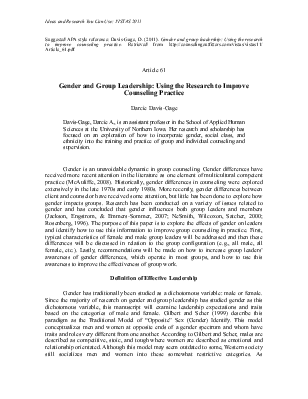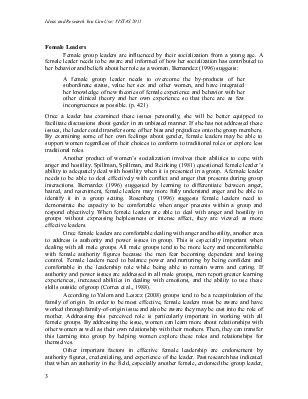







Article 61
Gender and Group Leadership: Using the Research to Improve Counseling Practice
Darcie Davis-Gage
Davis-Gage, Darcie A., is an assistant professor in the School of Applied Human Sciences at the University of Northern Iowa. Her research and scholarship has focused on an exploration of how to incorporate gender, social class, and ethnicity into the training and practice of group and individual counseling and supervision.
Gender is an unavoidable dynamic in group counseling. Gender differences have received more recent attention in the literature as one element of multicultural competent practice (McAuliffe, 2008). Historically, gender differences in counseling were explored extensively in the late 1970s and early 1980s. More recently, gender differences between client and counselor have received some attention, but little has been done to explore how gender impacts groups. Research has been conducted on a variety of issues related to gender and has concluded that gender influences both group leaders and members (Jackson, Engstrom, & Emmers-Sommer, 2007; NeSmith, Wilcoxon, Satcher, 2000; Rosenberg, 1996). The purpose of this paper is to explore the effects of gender on leaders and identify how to use this information to improve group counseling in practice. First, typical characteristics of female and male group leaders will be addressed and then these differences will be discussed in relation to the group configuration (e.g., all male, all female, etc.). Lastly, recommendations will be made on how to increase group leaders’ awareness of gender differences, which operate in most groups, and how to use this awareness to improve the effectiveness of group work.
Definition of Effective Leadership
Gender has traditionally been studied as a dichotomous variable: male or female. Since the majority of research on gender and group leadership has studied gender as this dichotomous variable, this manuscript will examine leadership expectations and traits based on the categories of male and female. Gilbert and Scher (1999) describe this paradigm as the Traditional Model of “Opposite” Sex (Gender) Identify. This model conceptualizes men and women at opposite ends of a gender spectrum and whom have traits and roles very different from one another. According to Gilbert and Scher, males are described as competitive, stoic, and tough where women are described as emotional and relationship orientated. Although this model may seem outdated to some, Western society still socializes men and women into these somewhat restrictive categories. As
research on group leadership is explored in this paper, readers will notice these same themes about gender still operate within groups. The author recognizes that some individuals do not feel that those categories necessarily describe their gender, but exploring that topic is beyond the scope of this article. It is hoped by continuing to explore how male and female gender may impact group leadership, the field will start to explore gender in a more inclusive manner.
A variety of aspects are involved in identifying effective group leadership. Gladding (2008) recognized effective group leaders are flexible, versatile, and skilled in the core competences of group work (i.e., linking, facilitating, blocking); display personal characteristics of warmth and self-awareness; and are capable of handling conflict. Effective leaders also demonstrate the ability to nurture a sense of hope and display positive attitudes and emotional supportive behaviors (Dykeman & Appleton, 1998; Stockton, Morran, & Velboff, 1987). One challenge of exploring the topic of group leadership and gender is the actual definition of effective leadership. Kawakami, White, and Langer (2000) address an important double bind present in current research on gender and effective group leaders. Their literature revealed that some research has shown that traits of effective leaders tend to be associated with typical masculine traits (Hackman, Hills, Paterson, & Furniss, 1993) while other research has shown that effective leaders are ones who follow their stereotypical gender role or are “gender congruent” (Nieva & Gutek,1981). This tends to put women in a double bind: if they act feminine, they will not be seen as effective, but if they act masculine, they will be seen as gender incongruent and consequently ineffective. Kawakami et al. believed there were more elements of effective leadership than listed above and found if women used a genuine, mindful, and charismatic approach as a group leader, they were seen as effective whether they acted feminine or masculine.
Jackson et al. (2007) also demonstrated this double-bind might be changing. They conducted a study with undergraduate students who identified their preference for male or female leaders. Their results were in conflict with historical data which found that both men and women tended to choose male leaders over female leaders. Their results indicated men tended to choose male leaders and females tended to choose female leaders. Currently, it appears expectations regarding gender and leadership may be changing. By identifying these trends in the research, group leaders will be able to identify typical expectations members may have about them based on their gender and develop ways they can use their gender intentionally and effectively in group counseling.
Gender Difference and Group Leaders
The research reviewed in the previous section demonstrated that a variety of differences exist between how men and women may operate as leaders of groups. Some of these differences are related to gender specific expectations while others are related to actual differences between how men and women behave as group leaders. The following application section will explore how female and male leaders can account for gender differences and how these approaches may be modified for different types of groups.
2
Female Leaders
Female group leaders are influenced by their socialization from a young age. A female leader needs to be aware and informed of how her socialization has contributed to her behavior and beliefs about her role as a woman. Bernandez (1996) suggests:
A female group leader needs to overcome the by-products of her subordinate status, value her sex and other women, and have integrated her knowledge of new theories of female experience and behavior with her other clinical theory and her own experience so that there are as few incongruences as possible. (p. 421)
Once a leader has examined these issues personally, she will be better equipped to facilitate discussions about gender in an unbiased manner. If she has not addressed these issues, the leader could transfer some
Уважаемый посетитель!
Чтобы распечатать файл, скачайте его (в формате Word).
Ссылка на скачивание - внизу страницы.